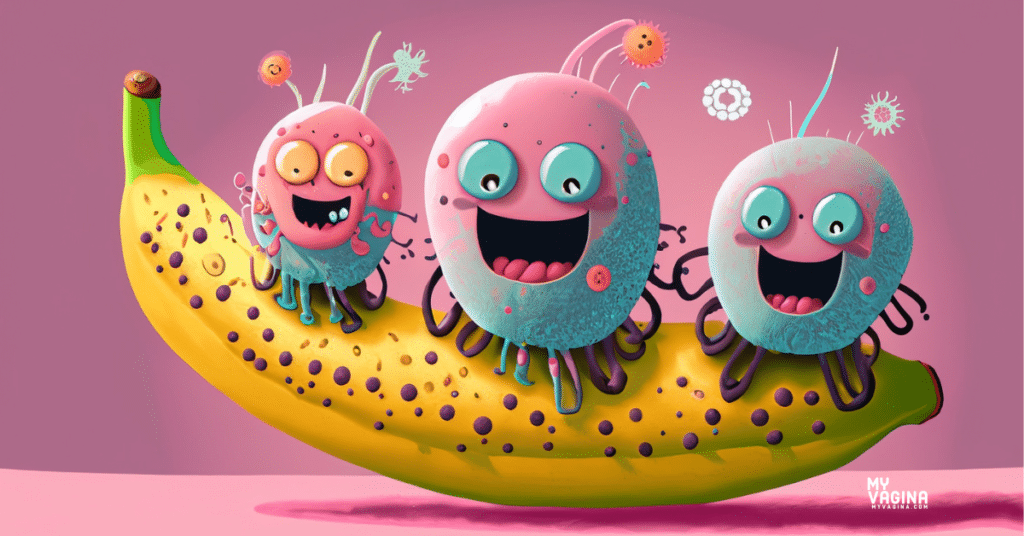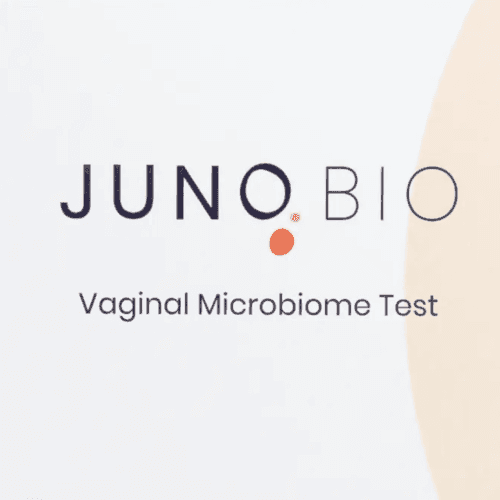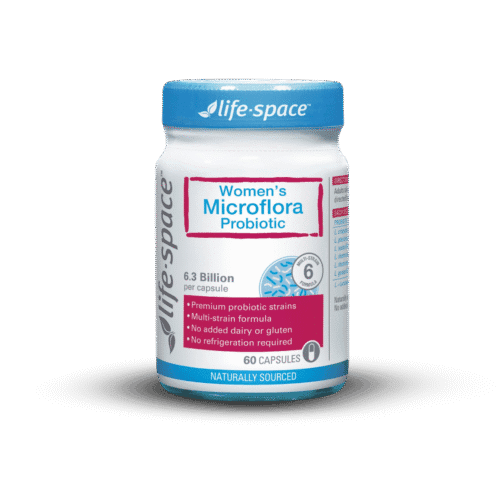We are just starting to appreciate the influences of microbiota on the various areas of the human body, particularly the gut microbiome1,2.
The gut microbiome impacts the immune system and neurobehaviour1, for instance. The vaginal and penile microbiomes are now being studied in much more detail, providing clues as to the underlying health of the genital and reproductive tracts3–5.
For once, most studies have focused on the vaginal microbiome and the impacts on fertility, pregnancy and infection. A protective vaginal microbiome consists of larger numbers of Lactobacillus species. The upper genital tract (uterus, fallopian tubes, ovaries) are also proving rich grounds for microbiome research3.
Bacteria in sperm
The male genital tract microbiome has only been more recently studied, in a limited capacity, which is less that men have been ignored, rather an assumption that men don’t have microbiome problems and therefore it was not worth studying. The opposite is becoming apparently true.
There is evidence that many bacteria are shared in the vagina and penis of sexual partners6, including those that cause bacterial vaginosis (BV). The male microbiome impacts fertility and the health of the male reproductive tract.7–12
Bacteria in the male genital tract has traditionally been associated with infection, with the most common conditions being orchitis, epididymitis, prostatitis and urethritis.
The majority of epididymo-orchitis symptoms are caused by sexually transmitted infections (STIs) such as chlamydia and gonorrhoea13,14, while acute and chronic prostatitis are usually caused by Escherichia coli, Klebsiella, Proteus, Pseudomonas aeruginosa, Enterococcus and Staphylococcus aureus14,15.
Bacteria in sperm (bacteriospermia) has been linked with male genital tract infections, but initially only because the reproductive tracts were supposedly sterile (now known to absolutely not be true).
The bacteria most commonly isolated from human sperm are members of the Staphylococcus, Enterococcus, Escherichia and Ureaplasma families16. New DNA testing methods show we’re covered in bacteria from top to toe, and the male genital tract is no exception17.
Collection of male samples
Collecting microbiome samples from the inner male reproductive tract is invasive and difficult to perform. So far the most common sample types have been take from prostate cancer or infertility cases, skewing the sample group from what might be considered normal or healthy.
Microbiome of testes, epididymis and vas deferens
Research has demonstrated that the testes (with no signs of infection or inflammation) contain low abundant bacteria.
Alfano et al did a comparison between the bacteria of two different groups of men, with Firmicutes and Actinobacteria were the two groups in greatest abundance, with men with azoospermia (no sperm in ejaculate) showing a significant increased abundance of Actinobacteria and decreased Proteobacteria and Bacteriodetes.
Another study questioned the existence of a testicular microbiome, suggesting contamination18. However, testicular microbiota found include Blautia, Cellulosibacter, Clostridium XIVa, Clostridium XIVb, Clostridium XVIII, Collinsella, Prevotella, Prolixibacter, Robinsoniella, and Wandonia. Prevotella was found to be one of the main components of the seminal microbiome19.
Men undergoing vasectomy had the microbial composition of semen evaluated before and after the surgery, with vasectomy resulting in a decrease in α-diversity, but overall the samples were not vastly different20.
Microbiome of the prostate, seminal vesicles and bulbourethral glands
Semen is comprised mainly of fluids from accessory glands – the prostate, seminal vesicles and bulbourethral glands. Interest in the microbiomes of these glands is increasing in terms of the relationship with prostate cancer20.
Studies show the existence of a prostatic microbiome.21,22
Samples taken from men with aggressive prostate cancer showed the Enterobacteteriaceae family was highly prevalent – 37-81%. Escherichia spp. were found in all samples, at around 30% of all results. Other bacterial families included Actinobacteria, Pseudomonas and Streptococcus, though at very low abundance.23
In another study into the bacterial patterns of prostate biopsies found Actinobacteria dominated, followed by Firmicutes and Proteobacteria. Major species included Proionibacterium, Corynebacterium, and Staphylococcus. Prevotella was, interestingly, not detected, despite being found in high abundance in other studies.24
In men with benign prostatic hyperplasia (BPH), Proteobacteria were dominant (around 50%)25. The bacterial patterns did not match those found by Next Generation Sequencing (NGS) testing, as they were tested using older culturing methods which are not as specific. A similar study found Firmicutes dominated in BPH26.
The urinary microbiome and prostate microbiome were significantly different, indicating a unique local colony.
The seminal vesicle and bulbourethral gland microbiomes remain unknown due to sampling challenges. In one study of the seminal vesicles Firmicutes were dominant (52%), followed by Bacteroidetes (22%), Proteobacteria (13%), Actinobacteria (10%) and Fusobacteria (2%). Specific genera included Bacteroides (9%), Lactobacillus (5%), Bifidobacterium (5%) and Faecalibacterium (5%).27
Patients with and without signs of infection didn’t differ significantly, but importantly, samples from seminal vesicles didn’t differ greatly from urine samples obtained prior to the operation, highlighting possible contamination.
Urethral microbiome
Studies have examined the microbial content of first void urine samples28–30 of men, and urethral samples29 with both samples showing similar bacterial profiles. Recurring themes include Lactobacillus, Streptococcus, Sneathia, Veillonella, Corynebacterium and Prevotella. The most common STI was gonorrhoea.
However, other studies found that the sampling types revealed different microbiome patterns28, implying a specific urethral microbiome31, with first-catch and mid-stream urine samples showing significantly different alpha diversity.
In first-catch urine samples, Prevotella, Streptococcus and Campylobacter were abundant.
The urethral microbiome was influenced in men with and without urethritis and depended on the sex of their partner. Haemophilus influenzae was significantly increased in men with male partners, while Corynebacterium spp. was significantly increased in men with female partners.
Microbiome of the penis and glans
Penile skin has been examined for its microbiota composition multiple times32–34, with results showing colonisation patterns dominated by Corynebacterium and Staphylococcus, which are typical skin commensals5,35.
The sexual entry sites for STIs are the foreskin mucosa and penis glans, with dysbiosis with anaerobic bacteria increasing the risk of HIV infection7–9. Anaerobic-dominant microbiomes influence local production of inflammatory cytokines which impact the immune system, with Peptostreptococcus, Prevotella and Dialister increasing cytokine production, attracting HIV-susceptible CD4+ T cells to the inner foreskin36.
Circumcision is seen to drastically impact the penile microbiome, with increased access to oxygen reducing anaerobic species such as Prevotella, Anaerococcus, Finegoldia and Peptoniphilus.
Circumcision was also associated with lower bacterial load and diversity, increasing Corynebacterium spp. and Staphylococcus spp.
Circumcision is also associated with a reduction in bacterial vaginosis in female partners37. If the penile microbiome is largely anaerobic, this may trigger immune system activation and an increase in STIs38.
Microbiome of semen
The most abundant genera found in the seminal microbiome were Ralstonia, Lactobacillus, Corynebacterium, Streptococcus and Staphylococcus. Anaerococcus was associated with poorer sperm quality.39
Three seminal bacterial community types have been identified:
- G1 (Pseudomonas-predominant group)
- G2 (Lactobacillus-predominant group)
Associated with better sperm quality - G3 (Prevotella-predominant group)
Associated with poorer sperm quality
Gardnerella vaginalis – associated with BV – was positively correlated with sperm quality40.
Low motility and abnormal spermiograms were associated with Prevotella-predominant microbiota. Increased abundance of Lactobacillus spp. was correlated with normal semen morphology. Staphylococcus was linked to normal spermiogram and high total motility. Overall, low abundance was confirmed.41–43
All studies, however, do not agree, which may be due to geographical or testing differences affecting the microbiome.
In other research, pathogenic bacteria (Neisseria spp., Klebsiella spp., and Pseudomonas spp.) were associated with seminal thickness (hyperviscosity) and low sperm count.
A high prevalence of Enterococcus spp. was found. In infertile men, Aerococcus, Rhodocytophaga and Gemella were increased, and in normal sperm, Colinsella spp.44
References
- 1.Gilbert JA, Blaser MJ, Caporaso JG, Jansson JK, Lynch SV, Knight R. Current understanding of the human microbiome. Nat Med. Published online April 2018:392-400. doi:10.1038/nm.4517
- 2.Valdes AM, Walter J, Segal E, Spector TD. Role of the gut microbiota in nutrition and health. BMJ. Published online June 13, 2018:k2179. doi:10.1136/bmj.k2179
- 3.Ma B, Forney LJ, Ravel J. Vaginal Microbiome: Rethinking Health and Disease. Annu Rev Microbiol. Published online October 13, 2012:371-389. doi:10.1146/annurev-micro-092611-150157
- 4.Zuber A, Peric A, Pluchino N, Baud D, Stojanov M. Human Male Genital Tract Microbiota. IJMS. Published online April 8, 2023:6939. doi:10.3390/ijms24086939
- 5.Gonçalves MFM, Fernandes ÂR, Rodrigues AG, Lisboa C. Microbiome in Male Genital Mucosa (Prepuce, Glans, and Coronal Sulcus): A Systematic Review. Microorganisms. Published online November 22, 2022:2312. doi:10.3390/microorganisms10122312
- 6.Day E, Galiwango RM, Park D, et al. Insertive vaginal sex is associated with altered penile immunology and enrichment of Gardnerella vaginalis in uncircumcised Ugandan men. American J Rep Immunol. Published online December 6, 2023. doi:10.1111/aji.13801
- 7.Prodger JL, Abraham AG, Tobian AAR, et al. Penile bacteria associated with HIV seroconversion, inflammation, and immune cells. JCI Insight. Published online April 22, 2021. doi:10.1172/jci.insight.147363
- 8.Liu CM, Prodger JL, Tobian AAR, et al. Penile Anaerobic Dysbiosis as a Risk Factor for HIV Infection. Blaser MJ, ed. mBio. Published online September 6, 2017. doi:10.1128/mbio.00996-17
- 9.Onywera H, Williamson AL, Ponomarenko J, Meiring TL. The Penile Microbiota in Uncircumcised and Circumcised Men: Relationships With HIV and Human Papillomavirus Infections and Cervicovaginal Microbiota. Front Med. Published online July 30, 2020. doi:10.3389/fmed.2020.00383
- 10.Baud D, Pattaroni C, Vulliemoz N, Castella V, Marsland BJ, Stojanov M. Sperm Microbiota and Its Impact on Semen Parameters. Front Microbiol. Published online February 12, 2019. doi:10.3389/fmicb.2019.00234
- 11.Alfano M, Ferrarese R, Locatelli I, et al. Testicular microbiome in azoospermic men—first evidence of the impact of an altered microenvironment. Human Reproduction. Published online May 30, 2018:1212-1217. doi:10.1093/humrep/dey116
- 12.Ding N, Zhang X, Zhang XD, et al. Impairment of spermatogenesis and sperm motility by the high-fat diet-induced dysbiosis of gut microbes. Gut. Published online January 2, 2020:1608-1619. doi:10.1136/gutjnl-2019-319127
- 13.Lam JC, Lang R, Stokes W. How I manage bacterial prostatitis. Clinical Microbiology and Infection. Published online January 2023:32-37. doi:10.1016/j.cmi.2022.05.035
- 14.Ireton RC, Berger RE. Prostatitis and Epididymitis. Urologic Clinics of North America. Published online February 1984:83-94. doi:10.1016/s0094-0143(21)00747-3
- 15.Farahani L, Tharakan T, Yap T, Ramsay JW, Jayasena CN, Minhas S. The semen microbiome and its impact on sperm function and male fertility: A systematic review and meta‐analysis. Andrology. Published online October 7, 2020:115-144. doi:10.1111/andr.12886
- 16.Jarvi K, Lacroix JM, Jain A, Dumitru I, Heritz D, Mittelman MW. Polymerase chain reaction-based detection of bacteria in semen. Fertility and Sterility. Published online September 1996:463-467. doi:10.1016/s0015-0282(16)58520-3
- 17.Lacroix JM, Jarvi K, Batra SD, Heritz DM, Mittelman MW. PCR-based technique for the detection of bacteria in semen and urine. Journal of Microbiological Methods. Published online July 1996:61-71. doi:10.1016/0167-7012(96)00844-5
- 18.Molina NM, Plaza-Díaz J, Vilchez-Vargas R, et al. Assessing the testicular sperm microbiome: a low-biomass site with abundant contamination. Reproductive BioMedicine Online. Published online September 2021:523-531. doi:10.1016/j.rbmo.2021.06.021
- 19.Weng SL, Chiu CM, Lin FM, et al. Bacterial Communities in Semen from Men of Infertile Couples: Metagenomic Sequencing Reveals Relationships of Seminal Microbiota to Semen Quality. Abdo Z, ed. PLoS ONE. Published online October 23, 2014:e110152. doi:10.1371/journal.pone.0110152
- 20.Suarez Arbelaez MC, Israeli JM, Tipton CD, et al. Pilot Study: Next-generation Sequencing of the Semen Microbiome in Vasectomized Versus Nonvasectomized Men. European Urology Focus. Published online January 2023:75-82. doi:10.1016/j.euf.2022.11.010
- 21.Berger RE, Krieger JN, Rothman I, Muller CH, Hillier SL. Bacteria in the Prostate Tissue of Men With Idiopathic Prostatic Inflammation. Journal of Urology. Published online March 1997:863-865. doi:10.1016/s0022-5347(01)65066-3
- 22.Lee JC. Microbiology of the Prostate. Curr Urol Rep. Published online June 2000:159-163. doi:10.1007/s11934-000-0052-y
- 23.Rizzo A, Santoni M, Mollica V, Fiorentino M, Brandi G, Massari F. Microbiota and prostate cancer. Seminars in Cancer Biology. Published online November 2022:1058-1065. doi:10.1016/j.semcancer.2021.09.007
- 24.Cavarretta I, Ferrarese R, Cazzaniga W, et al. The Microbiome of the Prostate Tumor Microenvironment. Eur Urol. 2017;72(4):625-631. doi:10.1016/j.eururo.2017.03.029
- 25.Jain S, Samal AG, Das B, et al. Escherichia coli, a common constituent of benign prostate hyperplasia‐associated microbiota induces inflammation and DNA damage in prostate epithelial cells. The Prostate. Published online August 24, 2020:1341-1352. doi:10.1002/pros.24063
- 26.Okada K, Takezawa K, Tsujimura G, et al. Localization and potential role of prostate microbiota. Front Cell Infect Microbiol. Published online December 7, 2022. doi:10.3389/fcimb.2022.1048319
- 27.Lei H, Han H, Feng Y, Zhang X, Xin Z, Tian L. Altered microbiota profile in seminal vesicles of men presenting with refractory hematospermia. Mol Biol Rep. Published online December 30, 2022:2381-2389. doi:10.1007/s11033-022-08139-w
- 28.Hrbacek J, Morais D, Cermak P, Hanacek V, Zachoval R. Alpha-diversity and microbial community structure of the male urinary microbiota depend on urine sampling method. Sci Rep. Published online December 9, 2021. doi:10.1038/s41598-021-03292-x
- 29.Dong Q, Nelson DE, Toh E, et al. The Microbial Communities in Male First Catch Urine Are Highly Similar to Those in Paired Urethral Swab Specimens. Gray RH, ed. PLoS ONE. Published online May 13, 2011:e19709. doi:10.1371/journal.pone.0019709
- 30.Plummer EL, Ratten LK, Vodstrcil LA, et al. The Urethral Microbiota of Men with and without Idiopathic Urethritis. Fraser CM, ed. mBio. Published online October 26, 2022. doi:10.1128/mbio.02213-22
- 31.Nelson DE, Dong Q, Van Der Pol B, et al. Bacterial Communities of the Coronal Sulcus and Distal Urethra of Adolescent Males. Ravel J, ed. PLoS ONE. Published online May 11, 2012:e36298. doi:10.1371/journal.pone.0036298
- 32.Zozaya M, Ferris MJ, Siren JD, et al. Bacterial communities in penile skin, male urethra, and vaginas of heterosexual couples with and without bacterial vaginosis. Microbiome. Published online April 19, 2016. doi:10.1186/s40168-016-0161-6
- 33.Liu CM, Hungate BA, Tobian AAR, et al. Penile Microbiota and Female Partner Bacterial Vaginosis in Rakai, Uganda. Pettigrew MM, ed. mBio. Published online July 2015. doi:10.1128/mbio.00589-15
- 34.Onywera H, Williamson AL, Cozzuto L, et al. The penile microbiota of Black South African men: relationship with human papillomavirus and HIV infection. BMC Microbiol. Published online April 6, 2020. doi:10.1186/s12866-020-01759-x
- 35.Byrd AL, Belkaid Y, Segre JA. The human skin microbiome. Nat Rev Microbiol. Published online January 15, 2018:143-155. doi:10.1038/nrmicro.2017.157
- 36.Liu CM, Prodger JL, Tobian AAR, et al. Penile Anaerobic Dysbiosis as a Risk Factor for HIV Infection. Blaser MJ, ed. mBio. Published online September 6, 2017. doi:10.1128/mbio.00996-17
- 37.Gray RH, Kigozi G, Serwadda D, et al. The effects of male circumcision on female partners’ genital tract symptoms and vaginal infections in a randomized trial in Rakai, Uganda. American Journal of Obstetrics and Gynecology. Published online January 2009:42.e1-42.e7. doi:10.1016/j.ajog.2008.07.069
- 38.Prodger JL, Kaul R. The biology of how circumcision reduces HIV susceptibility: broader implications for the prevention field. AIDS Res Ther. Published online September 12, 2017. doi:10.1186/s12981-017-0167-6
- 39.Hou D, Zhou X, Zhong X, et al. Microbiota of the seminal fluid from healthy and infertile men. Fertility and Sterility. Published online November 2013:1261-1269.e3. doi:10.1016/j.fertnstert.2013.07.1991
- 40.Onderdonk AB, Delaney ML, Fichorova RN. The Human Microbiome during Bacterial Vaginosis. Clin Microbiol Rev. Published online April 2016:223-238. doi:10.1128/cmr.00075-15
- 41.Yang H, Zhang J, Xue Z, et al. Potential Pathogenic Bacteria in Seminal Microbiota of Patients with Different Types of Dysspermatism. Sci Rep. Published online April 23, 2020. doi:10.1038/s41598-020-63787-x
- 42.Zhao LL, Yao Y, Qiu XJ, et al. Semen microbiota in normal and leukocytospermic males. Asian J Androl. Published online 2022:398. doi:10.4103/aja202172
- 43.Štšepetova J, Baranova J, Simm J, et al. The complex microbiome from native semen to embryo culture environment in human in vitro fertilization procedure. Reprod Biol Endocrinol. Published online January 16, 2020. doi:10.1186/s12958-019-0562-z
- 44.Lundy SD, Sangwan N, Parekh NV, et al. Functional and Taxonomic Dysbiosis of the Gut, Urine, and Semen Microbiomes in Male Infertility. European Urology. Published online June 2021:826-836. doi:10.1016/j.eururo.2021.01.014








